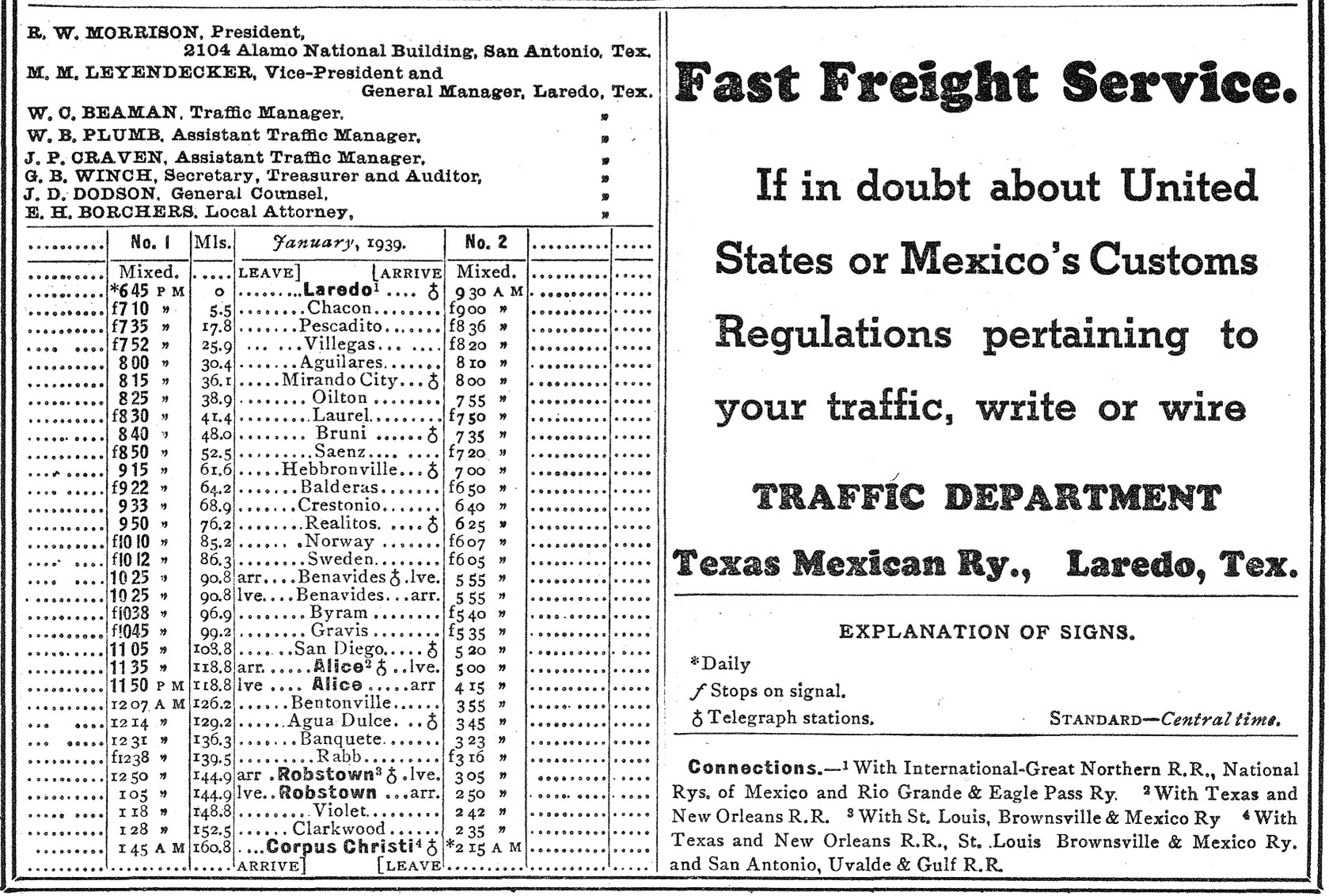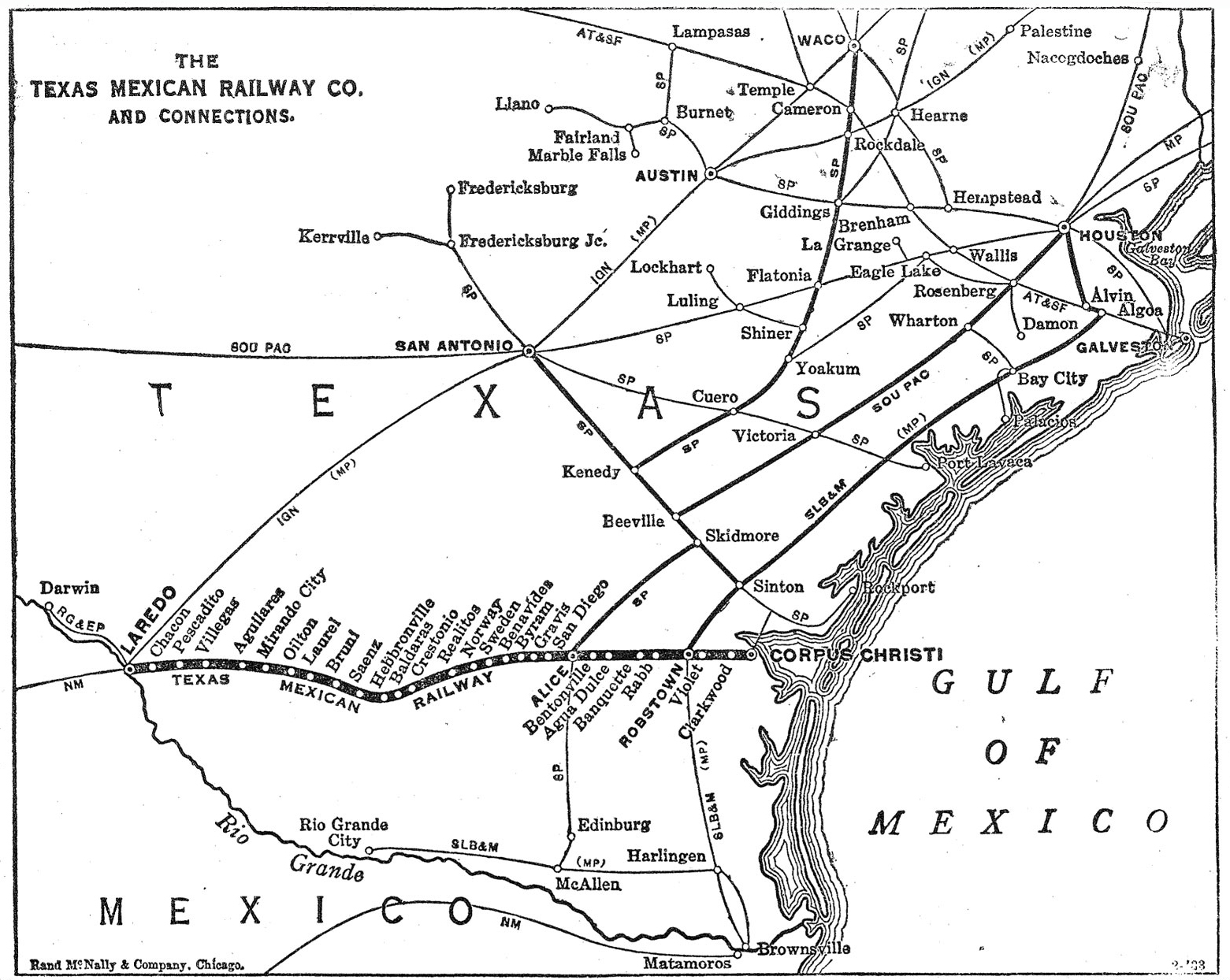Texas Mexican Railway: Serving The Border Since The 1880s
Last revised: September 4, 2024
By: Adam Burns
The Texas Mexican Railway, often known by its shortened name as Tex-Mex, is a small system operating in the southern
tip of Texas since the late 19th century.
The company started out as a narrow-gauge route but later switched to standard gauge. For much of its existence the railroad was owned by the Mexican government despite the fact that it was almost exclusively located in Texas between Laredo and Corpus Christi.
While railfans often either aren't aware of Tex-Mex or forget about the railroad it once operated an interesting fleet of early first-generation diesel locomotives.
When the Kansas City Southern began expanding south of the border it was able to acquire Tex-Mex in the early 2000s and today the line operates as a strategic bridge link in the Class I reaching its Transportación Ferroviaria Mexicana (TFM) subsidiary, today known as Kansas City Southern de México (KCSM).
Photos
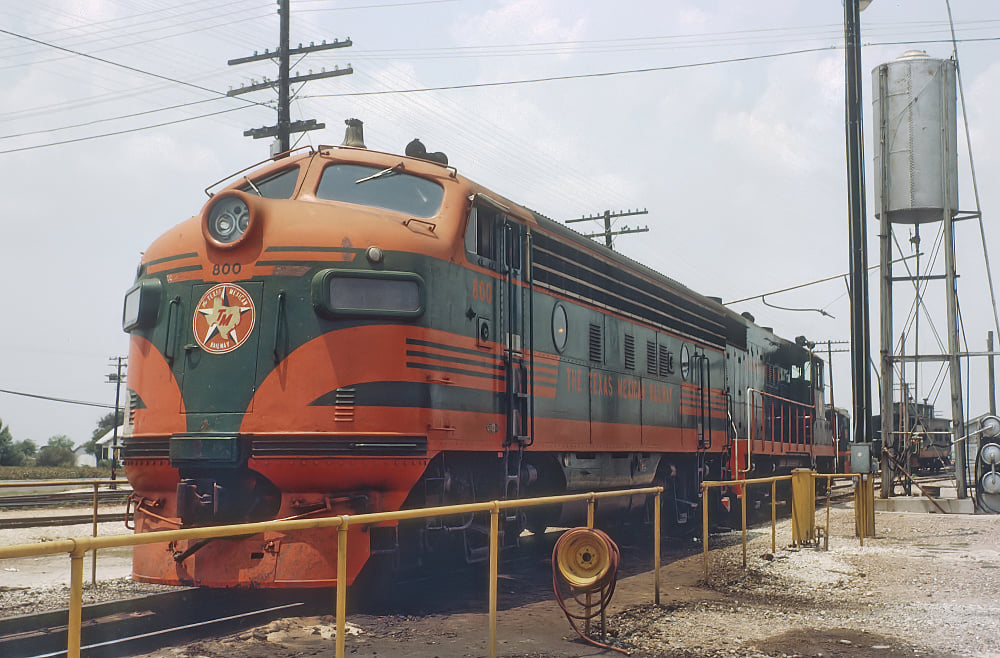 Tex Mex F7A #800 lays over at the railroad's engine facilities in Corpus Christi, Texas in August, 1965. Rick Burn photo.
Tex Mex F7A #800 lays over at the railroad's engine facilities in Corpus Christi, Texas in August, 1965. Rick Burn photo.History
The Texas Mexican Railway was chartered as the Corpus Christi, San Diego & Rio Grande Narrow Gauge Railroad Company of March, 1875 to construct a three-foot, narrow-gauge route from Corpus Christi (along the Gulf of Mexico) westward to San Diego, Texas.
This 52.1-mile route was opened four years later in 1879 and was meant to move sheep along farms in the southern tip of the Lone Star State to market at Corpus Christi (where they would then be shipped across the Gulf).
Just two years after the railroad opened it was sold to a new group of investors and renamed and re-chartered as the Texas Mexican Railway Company in 1881.
The head of this group was led by William J. Palmer and James Sullivan who, with a strong financial backing, were already working to finish their Mexican National Railway. This company was also a narrow-gauge line and opened its main line seven years later between Mexico City and Laredo, Texas in September of 1888.
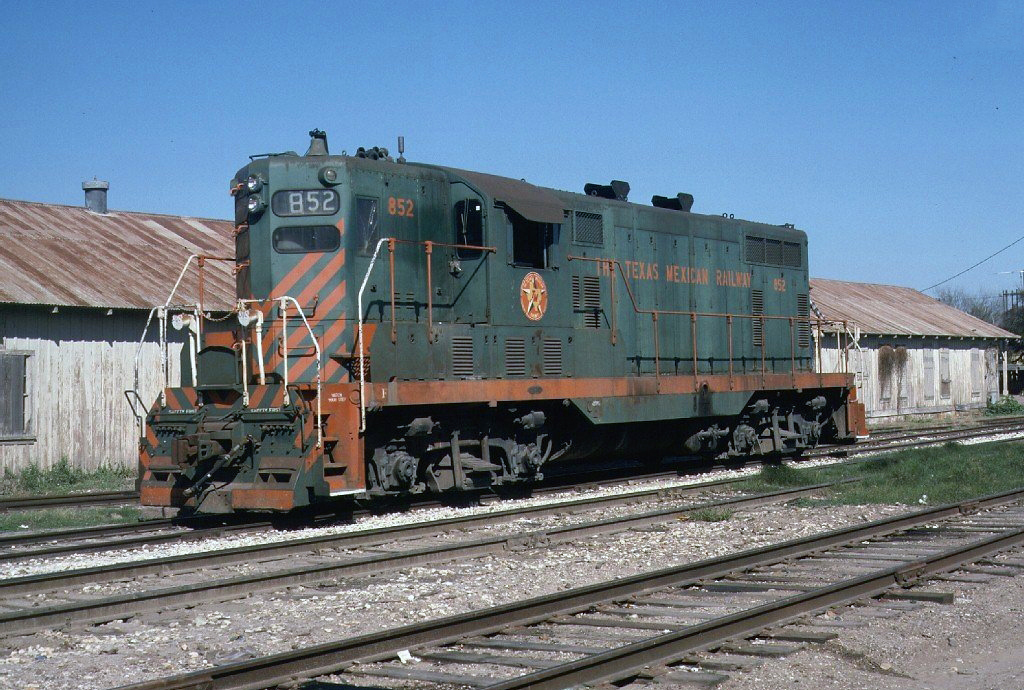 Tex-Mex GP7 #852 is tied down in Laredo during February of 1986. Gary Morris photo.
Tex-Mex GP7 #852 is tied down in Laredo during February of 1986. Gary Morris photo.Since the takeover of the Tex-Mex in 1881 the investors used their Mexican National to operate the company (until it opened in 1888) with hopes to complete the railroad to Laredo, Texas at the Mexican border, thereby providing a through route from Corpus Christi to Mexico City.
This 108.1-mile extension west from San Diego was finished within a few years and in 1883 a bridge was built over the Rio Grande River to Nuevo Laredo, Tamaulipas, Mexico (across the river from Laredo) thereby making the railroad the first to serve both countries.
Timetables
The 1880s also saw several other additions to the Tex-Mex system; in 1881 it had acquired the small Galveston, Brazos & Colorado Railroad that served Galveston (although an extension northward to reach it never happened).
In addition, during 1885 it connected with the San Antonio & Aransas Pass Railway at Alice, Texas giving it another interchange to Mexico (this company later became part of the Southern Pacific).
System Map
Interestingly, Palmer and Sullivan had quite a lofty goal for the rail system; their charter stipulated a railroad that was some 1,400 miles in length with extensions reaching Tyler, San Antonio, Galveston, and Sabine Pass.
Except for the purchase of the Galveston, Brazos & Colorado mentioned above there was no further effort in expanding the Tex-Mex to complete its charter to these cities. Instead, it focused almost exclusively on southern Texas and Mexico.
The turn of the 20th century saw the company complete some of its last major expansions and upgrades; on July 17, 1902 the entire route was switched to standard-gauge and in 1906 it took over the small Texas Mexican Northern Railway Company.
This system had hopes of completing a roughly 100-mile route up the Rio Grande River to Eagle Pass. Unfortunately, it stalled in 1882 after just five miles of track were completed outside of Laredo. Under Tex-Mex ownership just over a mile was used as a spur to serve nearby stock pens.
The year 1900 saw the Mexican government acquire control of the Texas Mexican Railway and would not relinquish it for more than 80 years.
Between 1930 and 1940 the Tex-Mex saw two final growth spurts; in 1930 it took over the San Diego & Gulf Railway Company and in 1940 began operating a 19-mile branch from Corpus Christi southward to Flour Bluff to serve a Naval air station located there.
The SD&G was a very small system established in 1929 by the Duval Texas Sulphur Company to construct a 2.85-mile line from the Tex-Mex at Byram to its sulfur mines at Palangana.
Nothing significant changed for the company until its 1982 privatization when the government sold it to Grupo TMM (Grupo Transportación Ferroviaria Mexicana).
Diesel Roster
| Builder | Model Type | Road Number | Date Built | Quantity |
|---|---|---|---|---|
| Whitcomb | Boxcab | 501-507 | 1939 | 7 |
| Baldwin | DS-4-4-750 | 509-510 | 1949 | 2 |
| Baldwin | VO-1000 | 511 | 1942 | 1 |
| EMD | F7A | 800A-800B | 1949 | 2 |
| EMD | GP7 | 850-852 | 1950-1951 | 3 |
| EMD | GP9 | 853 | 1958 | 1 |
| EMD | GP18 | 854-855 | 1963 | 2 |
| EMD | GP28 | 856 | 1965 | 1 |
| EMD | GP38 | 857-860 | 1966-1971 | 4 |
| EMD | GP38-2 | 861-867 | 1974-1985 | 7 |
| EMD | GP35 | 868 | Ex-Frisco | 1 |
| EMD | GP35M | 869 (1st) | Ex-MP | 1 |
| EMD | GP60 | 869 (2nd)-870 | 1990-1991 | 2 |
| EMD | GP40M-3 | 1161-1179 | Ex-SAL, Ex-B&O, Ex-L&N, Ex-C&O, Ex-SCL | 19 |
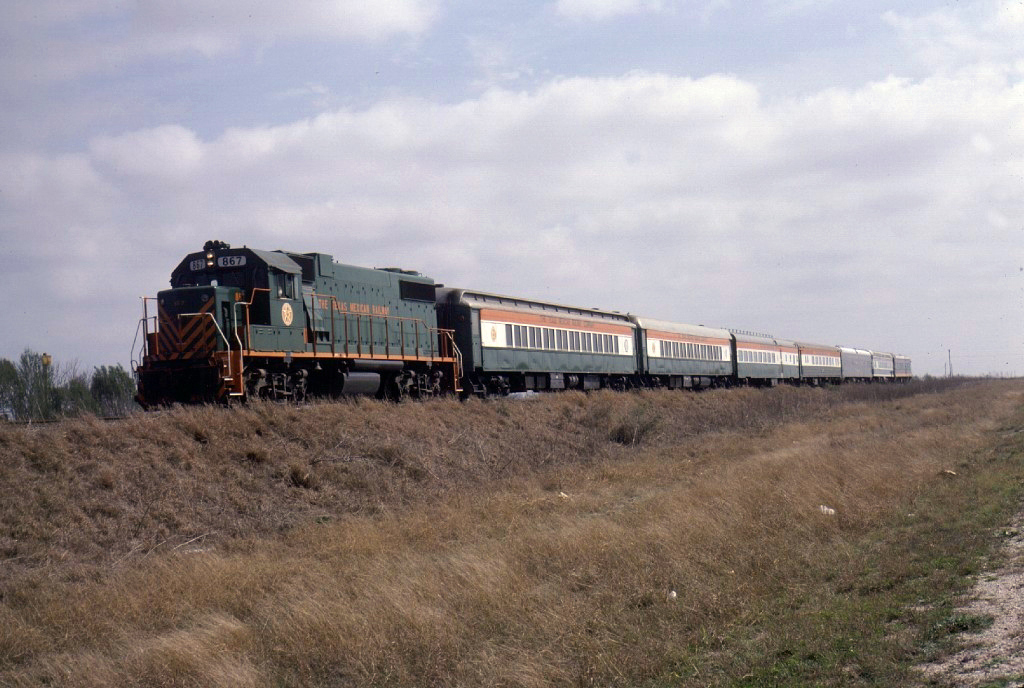 Tex-Mex GP38-2 #867 has the "Tex Mex Express" near Alice, Texas during February of 1986. This service was operated by the railroad at the time along the length of the railroad between Corpus Christi and Laredo. Gary Morris photo.
Tex-Mex GP38-2 #867 has the "Tex Mex Express" near Alice, Texas during February of 1986. This service was operated by the railroad at the time along the length of the railroad between Corpus Christi and Laredo. Gary Morris photo.The interest from Kansas City Southern began as early as the 1990s when it nearly acquired controlling interest in the Texas Mexican Railway.
After selling off ownership in 2002 back to Grupo TMM it did a complete 180-degrees two years later and took over the railroad in 2004 as a bridge route to its U.S. and Mexican rail lines, which now extend as far south as Veracruz, Mexico City, and Lazaro Cardenas.
Today, the Tex-Mex is still in existence on paper, although as a
wholly-owned subsidiary of Canadian Pacific-Kansas City (successor to KCS). Technically, the railroad operates 560
miles of trackage across Texas; its 160.1-mile original main line
between Laredo and Corpus Christi as well as 400 miles of trackage
rights between Corpus Christi, Houston and Beaumont.
Recent Articles
-
Maryland's - Wine Tasting - Train Rides
Jan 15, 26 02:59 PM
This article delves into the enchanting world of wine tasting train experiences in Maryland, providing a detailed exploration of their offerings, history, and allure. -
Colorado's - Wine Tasting - Train Rides
Jan 15, 26 02:46 PM
To truly savor these local flavors while soaking in the scenic beauty of Colorado, the concept of wine tasting trains has emerged, offering both locals and tourists a luxurious and immersive indulgenc… -
Iowa ~ Wine Tasting ~ Train Rides
Jan 15, 26 02:36 PM
The state not only boasts a burgeoning wine industry but also offers unique experiences such as wine by rail aboard the Boone & Scenic Valley Railroad. -
Georgia's Wine Train Rides In Cordele!
Jan 15, 26 02:26 PM
While the railroad offers a range of themed trips throughout the year, one of its most crowd-pleasing special events is the Wine & Cheese Train—a short, scenic round trip designed to feel like a t… -
Indiana ~ Murder Mystery ~ Dinner Train Rides
Jan 15, 26 02:22 PM
This piece explores the allure of murder mystery trains and why they are becoming a must-try experience for enthusiasts and casual travelers alike. -
Ohio ~ Murder Mystery ~ Dinner Train Rides
Jan 15, 26 02:10 PM
The murder mystery dinner train rides in Ohio provide an immersive experience that combines fine dining, an engaging narrative, and the beauty of Ohio's landscapes. -
Nevada Dinner Train Rides In Ely!
Jan 15, 26 02:01 PM
If you’ve ever wished you could step through a time portal into the hard-working world of a 1900s short line the Nevada Northern Railway in Ely is about as close as it gets. -
Michigan Dinner Train Rides In Owosso!
Jan 15, 26 09:46 AM
The Steam Railroading Institute is best known as the home of Pere Marquette #1225 and even occasionally hosts a dinner train! -
Arizona's - Wine Tasting - Train Rides
Jan 14, 26 02:04 PM
For those who want to experience the charm of Arizona's wine scene while embracing the romance of rail travel, wine tasting train rides offer a memorable journey through the state's picturesque landsc… -
Arkansas's - Wine Tasting - Train Rides
Jan 14, 26 01:57 PM
This article takes you through the experience of wine tasting train rides in Arkansas, highlighting their offerings, routes, and the delightful blend of history, scenery, and flavor that makes them so… -
Tennessee ~ Murder Mystery ~ Dinner Train Rides
Jan 14, 26 01:42 PM
Amidst the rolling hills and scenic landscapes of Tennessee, an exhilarating and interactive experience awaits those with a taste for mystery and intrigue. -
California ~ Murder Mystery ~ Dinner Train Rides
Jan 14, 26 01:26 PM
When it comes to experiencing the allure of crime-solving sprinkled with delicious dining, California's murder mystery dinner train rides have carved a niche for themselves among both locals and touri… -
Illinois ~ Murder Mystery ~ Dinner Train Rides
Jan 14, 26 01:13 PM
Among Illinois's scenic train rides, one of the most unique and captivating experiences is the murder mystery excursion. -
Vermont's - Murder Mystery - Dinner Train Rides
Jan 14, 26 12:57 PM
There are currently murder mystery dinner trains offered in Vermont but until recently the Champlain Valley Dinner Train offered such a trip! -
Massachusetts Dinner Train Rides On Cape Cod!
Jan 14, 26 12:20 PM
The Cape Cod Central Railroad (CCCR) has carved out a special niche by pairing classic New England scenery with old-school hospitality, including some of the best-known dining train experiences in the… -
Maine Dinner Train Rides In Portland!
Jan 14, 26 11:31 AM
While this isn’t generally a “dinner train” railroad in the traditional sense—no multi-course meal served en route—Maine Narrow Gauge does offer several popular ride experiences where food and drink a… -
Kentucky Dinner Train Rides In Bardstown!
Jan 13, 26 01:14 PM
The essence of My Old Kentucky Dinner Train is part restaurant, part scenic excursion, and part living piece of Kentucky rail history. -
Kansas Dinner Train Rides In Abilene!
Jan 13, 26 12:44 PM
If you’re looking for a heritage railroad that feels authentically Kansas—equal parts prairie scenery, small-town history, and hands-on railroading—the Abilene & Smoky Valley Railroad (A&SV) delivers. -
Michigan ~ Murder Mystery ~ Dinner Train Rides
Jan 13, 26 11:24 AM
Among the lesser-known treasures of this state are the intriguing murder mystery dinner train rides—a perfect blend of suspense, dining, and scenic exploration. -
Virginia's - Murder Mystery - Dinner Train Rides
Jan 13, 26 11:11 AM
Among the state's railroad attractions, murder mystery dinner trains stand out as a captivating fusion of theatrical entertainment, fine dining, and scenic travel. -
Arizona Dinner Train Rides At The Grand Canyon!
Jan 13, 26 10:59 AM
While the Grand Canyon Railway does not offer a true, onboard dinner train experience it does offer several upscale options and off-train dining. -
Georgia Dinner Train Rides In Nashville!
Jan 13, 26 10:27 AM
If you’ve ever wished you could slow down, trade traffic for jointed rail, and let a small-town landscape roll by your window while a hot meal is served at your table, the Azalea Sprinter delivers tha… -
Indiana Valentine's Train Rides
Jan 12, 26 04:27 PM
If you’ve ever wished you could step into a time when passenger trains were a Saturday-night treat and a whistle echoing across farm fields meant “adventure,” the Nickel Plate Express delivers that fe… -
Ohio Valentine's Train Rides!
Jan 12, 26 04:20 PM
The Hocking Valley Scenic Railway offers one of the region’s most atmospheric ways to experience the Hocking Hills area: from the rhythmic click of jointed rail to the glow of vintage coaches rolling… -
Wisconsin's - Wine Tasting - Train Rides
Jan 12, 26 03:10 PM
Wisconsin might not be the first state that comes to mind when one thinks of wine, but this scenic region is increasingly gaining recognition for its unique offerings in viticulture. -
California's - Wine Tasting - Train Rides
Jan 12, 26 02:34 PM
This article explores the charm, routes, and offerings of these unique wine tasting trains that traverse California’s picturesque landscapes. -
Wisconsin Scenic Train Rides In North Freedom!
Jan 12, 26 02:20 PM
The Mid-Continent Railway Museum is a living-history museum built around the sights, sounds, and everyday rhythms of small-town and shortline railroading in the early 20th century, what the museum cal… -
Vermont Scenic Train Rides In Burlington!
Jan 12, 26 01:18 PM
Today, GMRC is best known by many travelers for its Burlington-based passenger experiences—most famously the Champlain Valley Dinner Train and the sleek, limited-capacity Cocktails on the Rails. -
Maryland's - Murder Mystery - Dinner Train Rides
Jan 12, 26 01:03 PM
Maryland is known for its scenic landscapes, historical landmarks, and vibrant culture, but did you know that it’s also home to some of the most thrilling murder mystery dinner trains? -
Minnesota's - Murder Mystery - Dinner Train Rides
Jan 12, 26 12:17 PM
Murder mystery dinner trains offer an enticing blend of suspense, culinary delight, and perpetual motion, where passengers become both detectives and dining companions on an unforgettable journey. -
Vermont Dinner Train Rides In Burlington!
Jan 12, 26 12:09 PM
There is one location in Vermont hosting a dedicated dinner train experience at the Green Mountain Railroad. -
Connecticut Dinner Train Rides In Essex!
Jan 12, 26 10:39 AM
Connecticut's rail heritage can be traced back to the industry's earliest days and a few organizations preserve this rich history by offering train rides. The Essex Steam Train also hosts dinner-theme… -
Florida Scenic Train Rides In Parrish!
Jan 11, 26 10:26 PM
The Florida Railroad Museum (FRRM) in Parrish offers something increasingly rare in today’s rail landscape: a chance to ride historic equipment over a surviving fragment of an early-20th-century mainl… -
California's - Wine Tasting - Train Rides
Jan 11, 26 02:28 PM
This article explores the charm, routes, and offerings of these unique wine tasting trains that traverse California’s picturesque landscapes. -
Georgia's - Murder Mystery - Dinner Train Rides
Jan 11, 26 02:07 PM
In the heart of the Peach State, a unique form of entertainment combines the thrill of a murder mystery with the charm of a historic train ride. -
Colorado ~ Murder Mystery ~ Dinner Train Rides
Jan 11, 26 01:43 PM
Nestled among the breathtaking vistas and rugged terrains of Colorado lies a unique fusion of theater, gastronomy, and travel—a murder mystery dinner train ride. -
Minnesota Dinner Train Rides In Duluth!
Jan 11, 26 01:32 PM
One of the best ways to feel the region's history in motion today is aboard the North Shore Scenic Railroad (NSSR), which operates out of Duluth’s historic depot. -
Illinois Dinner Train Rides At Monticello!
Jan 11, 26 12:42 PM
The Monticello Railway Museum (MRM) is one of those places that quietly does a lot: it preserves a sizable collection, maintains its own operating railroad, and—most importantly for visitors—puts hist… -
Alabama's - Wine Tasting - Train Rides
Jan 10, 26 09:29 AM
While the state might not be the first to come to mind when one thinks of wine or train travel, the unique concept of wine tasting trains adds a refreshing twist to the Alabama tourism scene. -
Maryland Dinner Train Rides At WMSR!
Jan 10, 26 09:13 AM
The Western Maryland Scenic Railroad (WMSR) has become one of the Mid-Atlantic’s signature heritage operations—equal parts mountain railroad, living museum, and “special-occasion” night out. -
Arkansas Dinner Train Rides On The A&M!
Jan 10, 26 09:11 AM
If you want a railroad experience that feels equal parts “working short line” and “time machine,” the Arkansas & Missouri Railroad (A&M) delivers in a way few modern operations can. -
South Dakota's - Murder Mystery - Dinner Train Rides
Jan 10, 26 09:08 AM
While the state currently does not offer any murder mystery dinner train rides, the popular "1880 Train" at the Black Hills Central recently hosted these popular trips! -
Wisconsin's - Murder Mystery - Dinner Train Rides
Jan 10, 26 09:07 AM
Whether you're a fan of mystery novels or simply relish a night of theatrical entertainment, Wisconsin's murder mystery dinner trains promise an unforgettable adventure. -
Missouri's - Murder Mystery - Dinner Train Rides
Jan 10, 26 09:05 AM
Missouri, with its rich history and scenic landscapes, is home to one location hosting these unique excursion experiences. -
Washington ~ Murder Mystery ~ Dinner Train Rides
Jan 10, 26 09:04 AM
This article delves into what makes murder mystery dinner train rides in Washington State such a captivating experience. -
Kentucky Scenic Train Rides At KRM!
Jan 09, 26 11:13 PM
Located in the small town of New Haven the Kentucky Railway Museum offers a combination of historic equipment and popular excursions. -
Washington "Wine Tasting" Train Rides
Jan 09, 26 08:53 PM
Here’s a detailed look at where and how to ride, what to expect, and practical tips to make the most of wine tasting by rail in Washington. -
Kentucky's - Wine Tasting - Train Rides
Jan 09, 26 08:21 PM
Kentucky, often celebrated for its rolling pastures, thoroughbred horses, and bourbon legacy, has been cultivating another gem in its storied landscapes; enjoying wine by rail. -
Kentucky's - Murder Mystery - Dinner Train Rides
Jan 09, 26 01:12 PM
In the realm of unique travel experiences, Kentucky offers an enchanting twist that entices both locals and tourists alike: murder mystery dinner train rides. -
Utah's - Murder Mystery - Dinner Train Rides
Jan 09, 26 01:05 PM
This article highlights the murder mystery dinner trains currently avaliable in the state of Utah!

